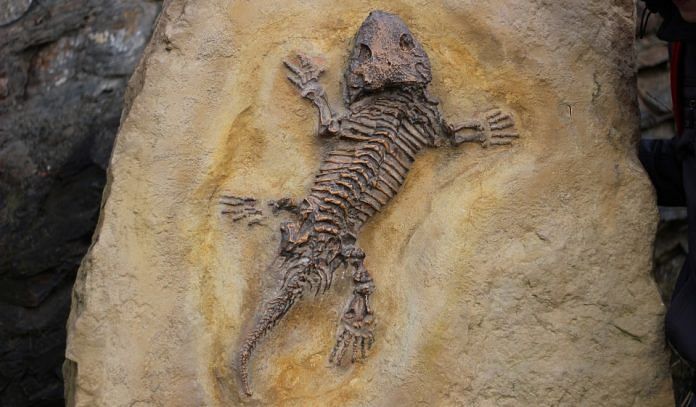New Delhi: Scientists in Canada have diagnosed an aggressive bone cancer, known as osteosarcoma, for the first time ever in a dinosaur.
The leg bone from a horned dinosaur that lived 76 to 77 million years ago was discovered in Canada in 1989. The deformed bone was originally thought to represent a healing fracture. However, a re-evaluation of the bone revealed unmistakable signs of advanced bone cancer, although scientists say that this particular dinosaur did not die from the cancer.
The fossil was found in a massive bonebed, suggesting that this dinosaur herd was struck down by a flood. The research highlights the importance of re-evaluating existing fossil specimens with new technologies to enable scientists to draw links between current human diseases and those of the past. More on Independent.
Ancient hell ant trapped in amber with its prey discovered in Myanmar
In Myanmar, scientists have discovered the fossil of a hell ant that had trapped an ancient insect with its unique headgear. The two insects from over 99 million years ago were trapped in amber, allowing scientists to get a glimpse of how the ancient hell ants hunted.
According to the researchers, catching extinct creatures in the act of predation is especially rare. Usually, based on fossils, scientists can only speculate how ancient species behaved.
Hell ants had scythe-like mandibles and a wide diversity of horns on the forehead. These features are not found in any living species. More on CNN.
SpaceX makes first successful splashdown in 45 years
Astronauts returning from the International Space Station have made a successful splashdown, or a water landing, for the first time in 45 years.
The last crew splashdown was in July 1975, when three NASA astronauts wrapped up the Apollo-Soyuz Test Project by landing in the middle of the Pacific Ocean.
While astronauts now regularly travel to the ISS, this particular mission marks the return of the first mission with commercial crew from the space station. The mission demonstrated SpaceX’s capacity to ferry astronauts to the space station and back. NASA will now use SpaceX services to ferry cargo and astronauts to the space station. Until now it had been relying on Russia’s Soyuz rockets for these trips. More on the BBC.
Canada loses its last fully intact Arctic ice shelf to global heating
The last fully intact ice shelf in Canada has collapsed, with more than 40 per cent of its area being lost in just two days at the end of July.
The Milne Ice Shelf was part of Nunavut, a sparsely populated northern Canadian territory.
The Arctic has been warming at twice the global rate for the last 30 years. This year, the polar sea ice shrank to the lowest extent for July in 40 years. Summer in the Canadian Arctic has been 5 degrees Celsius above the 30-year average. This has caused smaller ice caps to melt quickly, exposing more bedrock, which then heats up and further accelerates the melting of the glaciers.
A research camp based on this ice shelf was also lost due to the collapse. The researchers say that they were lucky to not have been on the shelf when it broke apart. More on Reuters.
Brightest-ever fluorescent materials can be 3D-printed into any shape
Scientists have successfully created the brightest known materials in existence — a fluorescent compound that can be used to 3D-print solid structure materials.
While there are currently more than 1,00,000 different fluorescent dyes available, almost none of these can be mixed in predictable ways to create solid optical materials. When dyes are solidified, there is a decrease in the intensity of their fluorescence to produce a more subdued glow.
The new materials have potential applications in any technology that needs bright fluorescence, including solar energy harvesting, bio-imaging and lasers. They may also be used for information storage and as well as 3D display technology. More on New Scientist.



